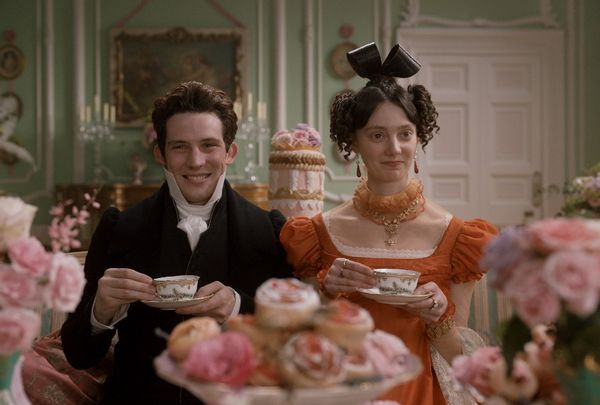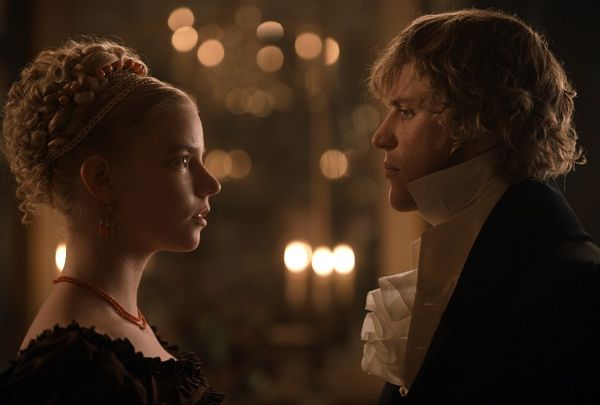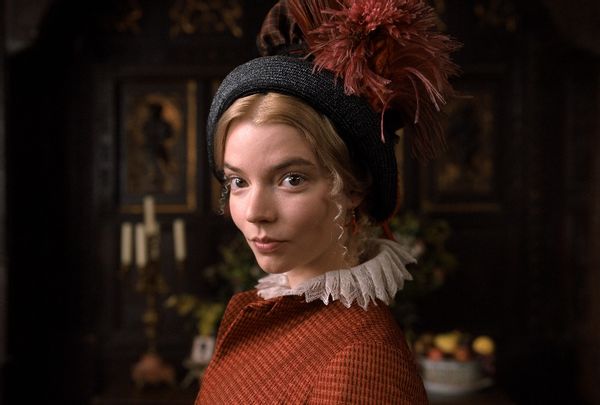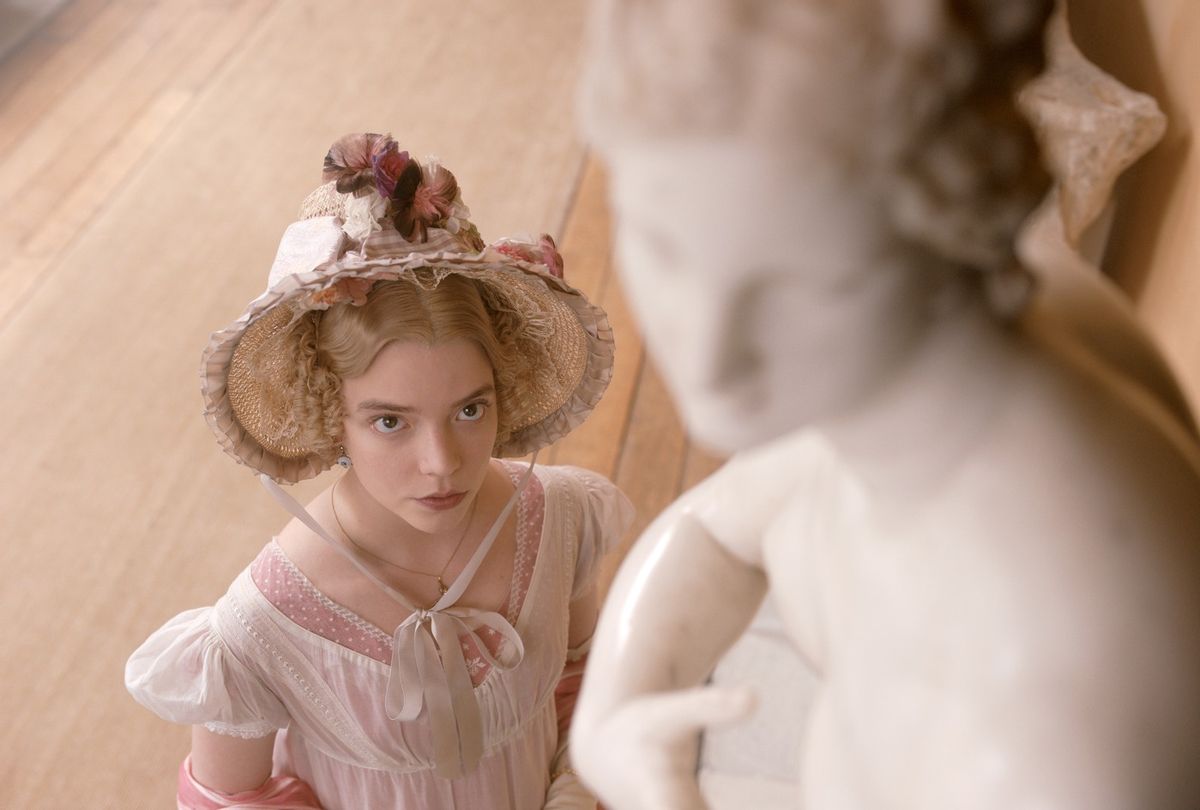Autumn de Wilde is chewing raw ginger slices in a Beverly Hills hotel room when I enter to discuss her directorial feature film debut, a sprightly new take on Jane Austen's Regency-era comedy "Emma."
"Sorry," she says with a cough, reacting to the root's potency. "Ginger – it's good for arthritis."
That remedy and de Wilde's ornate cane (with a hidden vial of whiskey contained within) are the only outward signs of her physical distress. They're reminders of the great equalizer – beyond all race, gender, class, profession, or temperament – that we are all creatures of flesh and bone, and subject to their annoying needs and whims. And how one deals with them can reveal much about one's character. This philosophy is at the heart of how de Wilde approached retelling "Emma" in a slapstick, yet ultimately humane fashion.
In the film, the attractive 21-year-old Emma Woodhouse (Anya Taylor-Joy) is enjoying a life of privilege and idleness. As the daughter of well-to-do landed gentry, she need not worry about marriage to live comfortably, and therefore sets out matchmaking for everyone else, including her new friend Harriet Smith (Mia Goth). Emma's impeccably behaved brother-in-law and close friend George Knightley (Johnny Flynn) does not approve of such meddling, though, and is the only one who will tell her so. As Emma matures, she realizes that her judgment is woefully lacking when it comes to matters of the heart.
Confinement through clothing

As a classic comedy of manners, "Emma." (period included in this version's title) certainly pokes at the characters' foibles through sharp dialogue and orchestrated social behaviors. But de Wilde observes that the root of etiquette is often physical, especially in the Regency/Georgian period in which "Emma." takes place. What one can get away with in polite society is often defined through strict limitations on how one dresses or moves.
"I've always been interested in sort of etiquette history . . . like, who the rebels were and how they dealt with that rebellion," says de Wilde, "like in the Jazz Age and how significant it was that they've taken off the corsets. So I was always kind of fascinated with fashion history and how it affected people's behavior."
The tight spiral curls, the corseted gowns, the fitted waistcoats, and the tailored breeches (the original skinny jeans!) all contribute to the perfect, carefully constructed image everyone is expected to convey. And when one plays with or does not adhere to these self-imposed limitations, one's true nature emerges. Therefore, "Emma." costume designer Alexandra Byrne offers sly clues to the vicar Mr. Elton's (Josh O'Connor) outsized ego with similarly outsized collars and sleeves, and to his wife's vanity with her over-the-top accessorizing, even when she preaches restraint.
But it's in one of the earliest scenes that de Wilde establishes the film's tone and literally cheeky approach to physicality. The audience is introduced to Mr. Knightley as he is dressing – or undressing as the case may be. Following in the rather new tradition of updated Austen adaptations, "Emma." features Knightley's naked bum.
"If I just did a nude scene just for kicks, it would be superficial. Part of it was about the giving him more of a physical expression this time around because I don't think I've ever seen that," de Wilde says.
"I was not interested at all in modernizing the story – not that that would be wrong. It's an iconic story; you could do anything with it. But I was really interested in doing things to remind people that they were vulnerable as humans. So him being nude, especially since he's really kind of a parading around, confident, powerful and much beloved – I wanted to see underneath that costume, under that armor that Mr. Knightley has and see that he's just a human man underneath that."
While having Mr. Knightley drop trou frees the character of his more traditional, stuffy demeanor, the scene itself also upends the gender expectations for nudity in films. This is also played out behind the camera for a production that star Taylor-Joy describes as full of "feminine energy . . . incredibly passionate women that wanted to tell this story."
Apparently, Flynn also noticed the distinction while filming the scene. "Johnny was like, 'I just realized I've never been like half-naked in a room surrounded by women. Usually the the opposite of that is very common. It just threw me; I'd never experienced that,'" says Taylor-Joy. "So I think it was educational for a lot of the men on our set, to understand what it was to be so outnumbered sometimes."
Mr. Knightley's existential distress

"Emma." also builds tension – both comedic and dramatic – through the characters' movements, and de Wilde points to Howard Hawk's 1938 film "Bringing Up Baby" as an inspiration for the tone. In the screwball comedy, Cary Grant plays a buttoned-up paleontologist, whom free-spirited heiress (Katharine Hepburn) mistakes for a zoologist and wrangles into helping her with a tame leopard, Baby.
"If we hadn't seen 'Bringing up Baby,' I don't think we would have understood the level of slapstick that Autumn wanted us to have," says Taylor-Joy. "How I played Emma – her feelings are shifting around so much and her thoughts are so quick that I almost saw her as a cartoon character with what I was doing with my face."
The film never quite descends into pratfalls or fart jokes (you've already seen a bare bottom – what more do you want?!), but the genteel physical comedy is hard to miss, whether it's through cringe-worthy social faux pas, hypocritical behavior, or just drawing out the middle syllable of "inn-ohhhh-cence." One can't help giggle at Emma's father Mr. Woodhouse – played gleefully by Bill Nighy – as he's first seen practically leaping downstairs, but then later presents himself as an anxious hypochondriac. And Emma's anguished discomfort holding her niece as if she were a squirming log needs no explanation.
The audience doesn't need to be experts in 19th century manners to understand the humor and tension derived from a breach of etiquette either. Instead, de Wilde hired coach Alexandra Reynolds to give the cast a two-week bootcamp on Austen-era movements.
Flynn says, "She wanted us to really understand every rule and how we how you sit, how you stand, how you engage with each other – all the laws of that. We had somebody on set with us all the time saying, 'You wouldn't pick up your glass without taking your glove off,' or, 'You'd never hold a lady's hand like that,' or, 'You'd ask this person to dance, but not this one.'
"That worked so well because then when you break those rules, or you can feel somebody not managing within that – the struggling because of the mental anguish within that very, stiff-collared society – it's really powerful, and you feel that. You feel that friction and that schism in who they should be and who they have to be and who they want to be."
This conflict can be seen in Mr. Knightley, who is often seen walking or running around the small village of Highbury, even though he's expected to ride in a carriage as befitting his rank and fortune.
"It's not in the novel, but here you see he often foregoes using his carriage in favor of walking . . . and someone says, 'That doesn't befit a gentleman,'" says Flynn. "I get the sense of him that he's in this big house, but he'd rather be the farmer working with his friend in the field. He'd like to be out herding sheep. You see his connection to the land. He has a sense of himself through the landscape that he's in, and walking through the fields is just a ritual for him."
The pinnacle of this struggle between what a character desires and the strictures of polite society occurs at the film's climax: when Emma and Knightley dance together, but suddenly realize their undeniable attraction to each other. Despite some intense eye contact, the two barely touch, but their physical yearning is palpable.
"Johnny and I, we're very synced up, very emotionally connected to one another. We both just kind of just let it happen naturally," says Taylor-Joy.
"They're first taking [dancing together] as a joke, bowing to each other like, 'Oh, this is so ridiculous.' And then by the third turn, they're like,'Your breathing has synced up with my breathing. Why am I getting hot? Why am I blushing? Are you blushing?' We just did it a whole bunch of different times, and hopefully you can you can feel that revelation."
The two friends are confused about the force of their feelings, but are interrupted from confronting each other. Thwarted to the point of frustration, Knightley runs home, throws himself on the floor, and tears his cravat and collar off as if he's trying to breathe.
"Talking with Autumn in developing [this character], this person had to have this kind of natural ease about his position in society, but also a kind of existential panic underneath it about his feelings for Emma," says Flynn. "At some point it actually starts to swallow him up. It just all seems like madness, and he has a little breakdown somewhere in the middle because of societal laws. You can barely see [it], but you get the sense of him trembling behind his stiff collar."
Emma's big, bloody nose for drama

As Emma matures, she must face some harsh truths about herself and how she has mismanaged others. This leads to several tearful scenes. Taylor-Joy tries to develop a different style of crying for each of her characters, but when it comes to Emma, her many bouts of tears had to be further differentiated.
"When Knightley is dressing her down [after she insults Miss Bates], she's almost sobbing like a baby, like it's almost like a tantrum and cry," the actress says. "But then after that when Harriet leaves her . . . she's trying so hard not to cry and so when one tear comes down, she instantly puts up her hand and stops it because it's like, 'She is Emma Woodhouse, and she will not crack. Not going to happen.'"
Not to be outdone by Knightley's panic attack, when Emma has her ultimate internal crisis, the way it manifests physically is that she literally bleeds. When the two would-be lovers finally confess their feelings to one another, Emma realizes that she's been wrong all along in her assumption that Knightley was wooing Harriet, and yet ecstatic from his confession of love for Emma herself. The confusing mix of emotions causes Emma to have a spontaneous nosebleed.
The plan for filming the scene was to cut away from Taylor-Joy, apply the fake blood, and then continue shooting. The actress' nose had other plans though.
"This is going to sound crazy, but please just roll with me on it. Whilst we were doing the scene, my nose started bleeding and it bled when it was supposed to [in the script]. I have no idea how it happened, but I got a nosebleed on cue," says Taylor-Joy.
"The B-roll is hilarious because luckily Johnny and Autumn really care about me so all you can hear is, 'Oh my god, are you okay? What do we do? What do we do?' And I was like, 'What are you mean what do we do? Keep f**king rolling! This is amazing! This is this is unbelievable!'"
Fortunately, this unexpectedly Method approach to acting worked for the scene, which circles back to de Wilde's approach to making Emma as relatable as possible.
"I'd get nosebleeds all the time. Every time I was in homeroom, and it was your turn to stand up and read something I would get a nosebleed. I'm so fascinated with the human body betraying you," says de Wilde.
"I thought, 'What are the things that remind people that they're humans?' No matter what the rules of the period are, you cannot control your body. It's so frustrating. Doesn't matter what polite society says or the do's and don'ts. If your nose bleeds, your nose bleeds. If you get a coughing fit, you get a coughing fit. If you start sneezing, or if you get the hiccups – these are all things that haven't changed in 200 years."
That bit of blood also propels the action along and acts as a catalyst for Emma to square things away with Harriet before pursuing her own happiness.
"There's an inherent problem in making a movie about Emma. In the book, it's fine that the story isn't over when the proposal happens, but in a movie, it can feel like that's the end, it's time to wrap things up. But Emma still has a bunch of work to do to fix things. And so I thought it would be really incredible to kind of have a natural interruption to a very romantic moment."
Just before wrapping up the interview, de Wilde adds that one more detail confirmed that giving Emma a bloody nose was the right choice in that moment.
"Eleanor Catton, my ingenious screenwriter, found out later that bloody noses are in Old English folklore are symbol of true love."
"Emma" is currently playing in New York and Los Angeles and will be in theaters everywhere on Friday, March 6.
Check back with Salon.com for more coverage of "Emma."

Shares